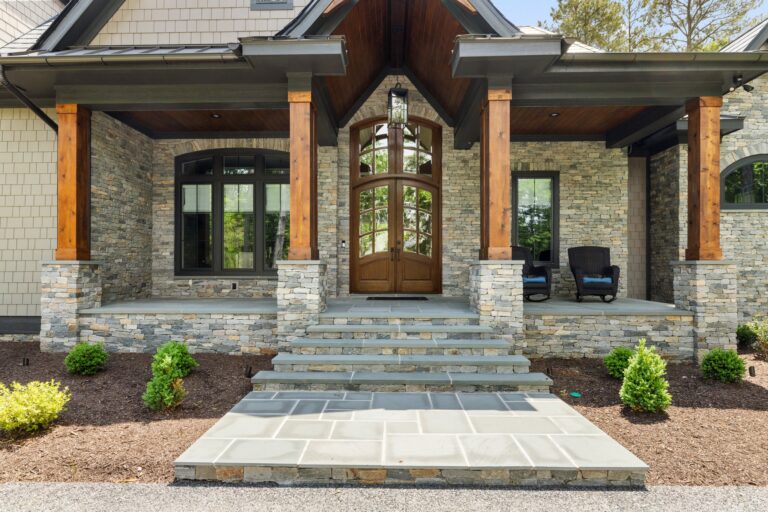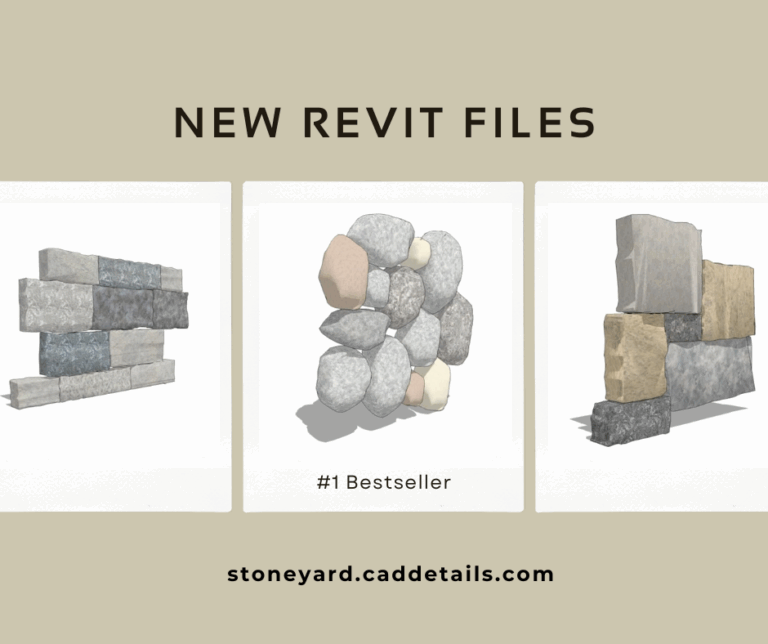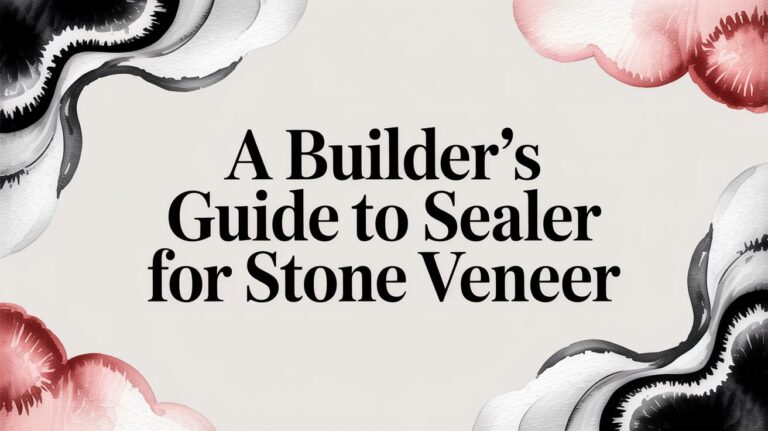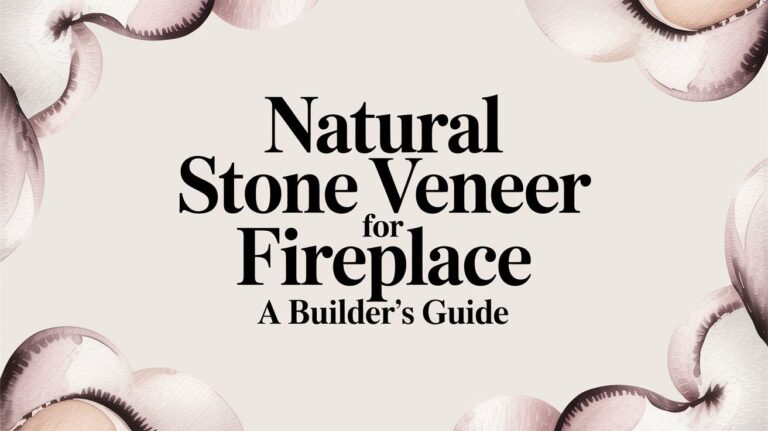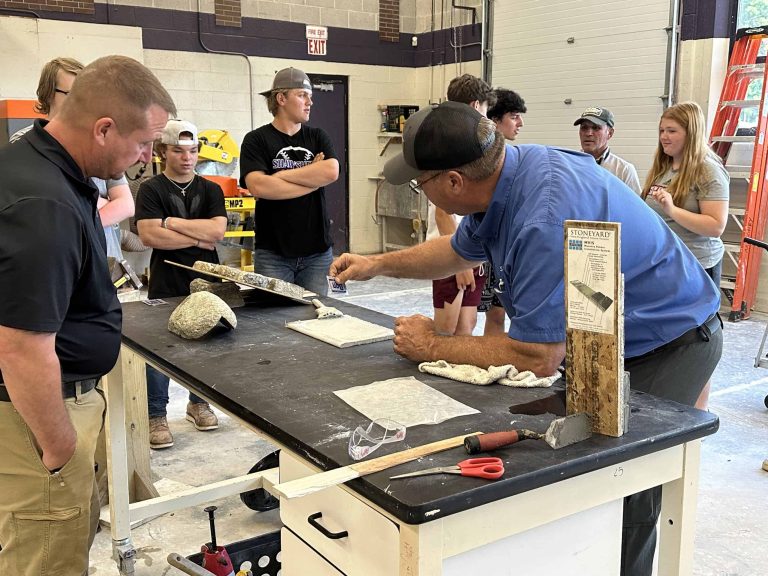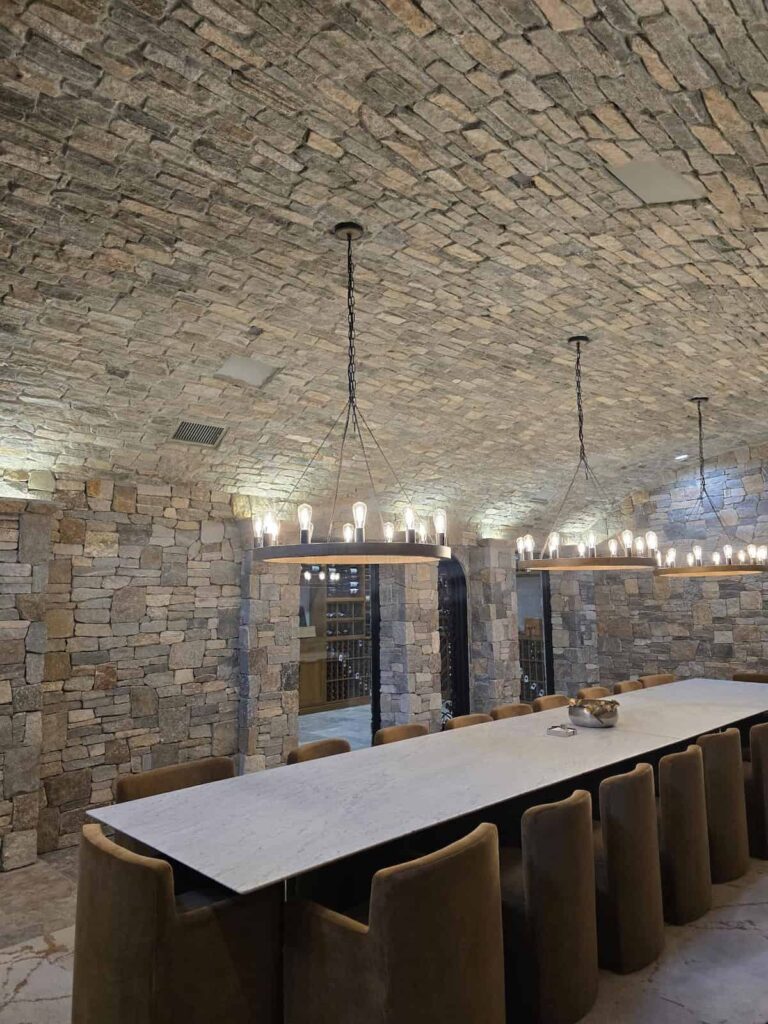Your cart is currently empty!
Stone Veneer on Fireplace: A Practical Installation Guide
Applying stone veneer on a fireplace transforms the focal point of a home, delivering the authentic look of full-thickness stone at a fraction of the weight. This approach uses real, sawn natural stone, making it a superior upgrade for both new construction and renovations.
Transform Your Fireplace with Natural Stone Veneer
A fireplace is the heart of a living room or commercial lobby. Cladding it in real stone anchors the space with a sense of permanence and character that manufactured materials cannot replicate.
Unlike cast concrete products, the natural thin stone veneer from Stoneyard is 100% authentic New England fieldstone and quarried stone, crafted at our facility in Littleton, Massachusetts. We saw each piece to an approximate thickness of one inch (¾–1¼ inch range). This achieves the full-depth look of traditional masonry without requiring a structural support ledge, reducing wall load and simplifying installation.
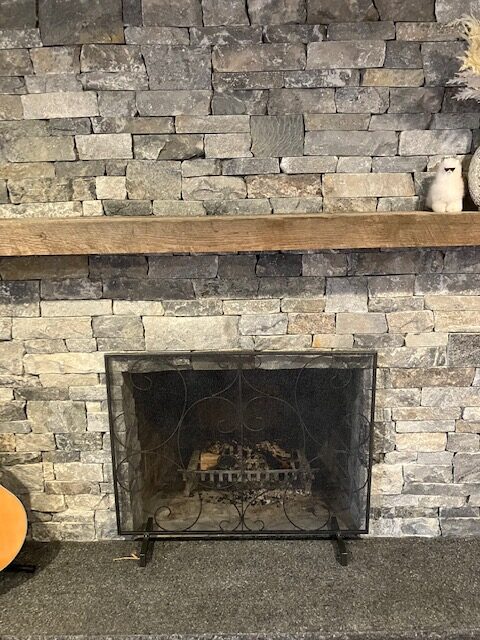
This modern application reduces material weight and installation complexity, making it a preferred choice for professional builders and remodelers. The global demand for durable, authentic architectural materials is growing, as detailed in market insights from Fortune Business Insights.
The Stoneyard Advantage
Our thin stone veneer is not a cast concrete imitation. It is 100% real stone, meaning the color and texture are consistent throughout each piece. It will not fade, flake, or delaminate—a common failure point for manufactured alternatives like Eldorado Stone or Cultured Stone when subjected to temperature fluctuations.
Key features for fireplace projects include:
- Authentic Material: Sourced directly from New England, our stone reflects the region’s unique geology and building heritage. It is Made in the USA.
- Proven Durability: Every product is Harsh Climate Approved (HCA) and tested for freeze–thaw cycles, ensuring performance for decades.
- Reduced Weight: Weighing less than 15 lbs/sq. ft., it installs over standard framed walls with metal lath and a scratch coat.
- Complete System: Every stone collection includes matching corner pieces, creating seamless returns that replicate the appearance of full-bed stone.
While faux stone products exist, the differences in durability, authenticity, and long-term value are significant.
Natural Stone Veneer vs. Manufactured Alternatives
| Attribute | Stoneyard Natural Thin Stone Veneer | Manufactured Stone (e.g., Eldorado Stone, Cultured Stone) |
|---|---|---|
| Material Composition | 100% real, quarried and fieldstone from New England | Cement, aggregates, and artificial pigments cast in molds |
| Durability | Harsh Climate Approved (HCA); naturally resistant to fading and freeze-thaw cycles. Lasts for generations. | Prone to fading from UV exposure; can absorb water, leading to cracking, chipping, or delamination. |
| Color Integrity | Color is consistent throughout the entire stone. Chips and cuts reveal more of the same natural material. | Surface-level color applied with pigments. A chip exposes the gray concrete base. |
| Long-Term Value | Adds significant, lasting real estate value. Develops a natural patina over time. | Can decrease in aesthetic appeal as it fades or deteriorates, potentially impacting property value. |
| Uniqueness | Every piece is unique, with no repetitive patterns. | Produced from molds, which can result in noticeable repeating patterns and an artificial appearance. |
Choosing genuine stone is an investment in a material that develops a natural patina over time, adding timeless character. The result is a low-maintenance fireplace surround that provides real, long-term value to any residential or commercial property.
Explore our complete collection of real New England thin stone veneer.
Why Real Stone Outperforms Manufactured Veneer
When selecting a material for a fireplace, the choice is often between real, natural stone and a manufactured veneer. While they may aim for a similar aesthetic, their composition, performance, and long-term value are fundamentally different. Understanding these distinctions is key to building a fireplace that is both visually appealing and structurally sound for decades.
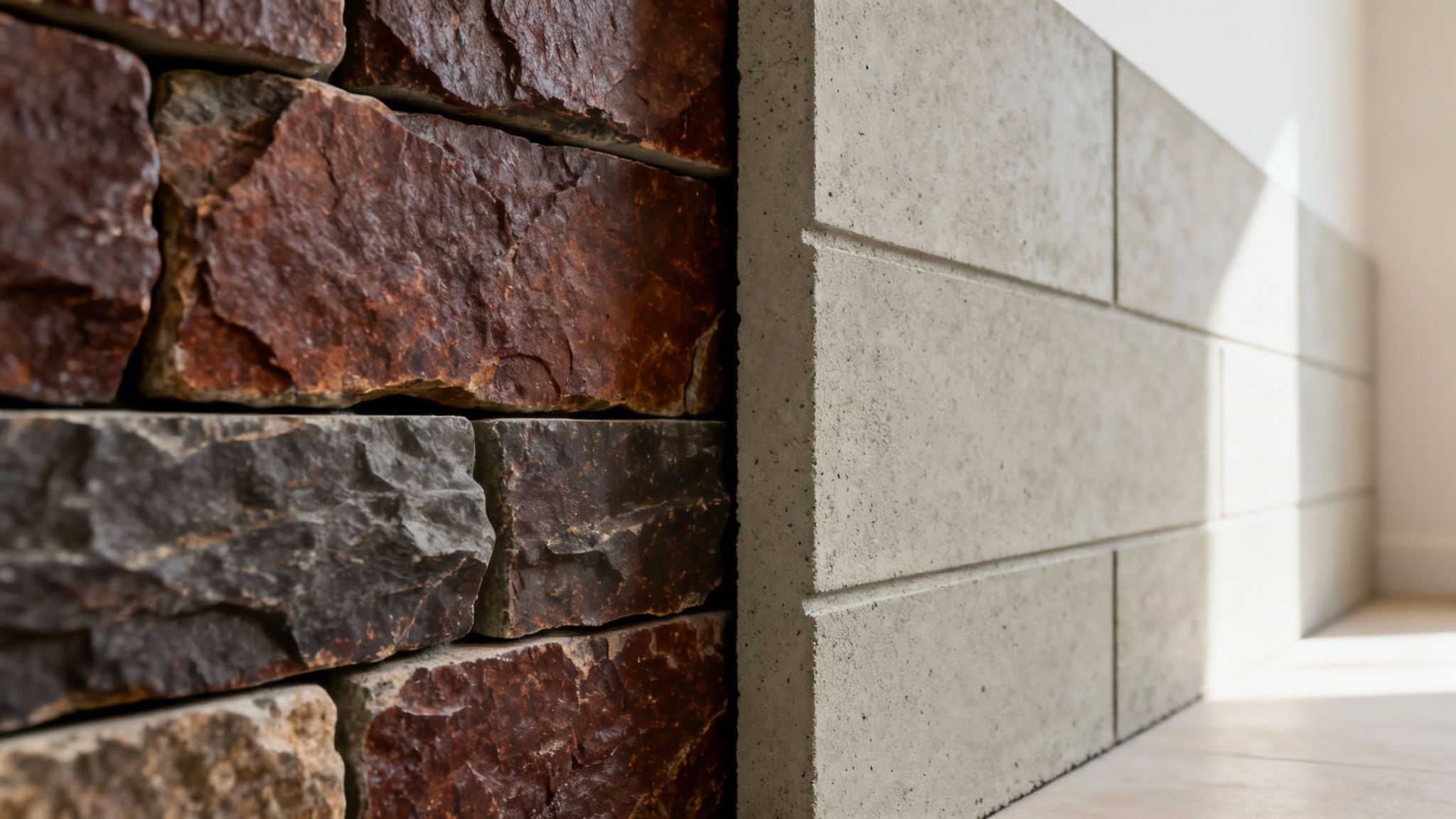
Products from brands like Eldorado Stone, Coronado Stone, and Cultured Stone are cement-based veneers. The process involves pouring a concrete mix into molds and applying surface pigments to imitate the look of stone. While they may have a lower upfront cost, their long-term performance, especially around a heat source, is a known concern.
The popularity of manufactured stone is noted in recent market analysis on stone veneer trends. However, this convenience comes with trade-offs in durability and authenticity.
Material Integrity and Durability
The primary difference is the material itself. Stoneyard’s product is 100% real New England stone, quarried or gathered as fieldstone and sawn to approximately one inch thick at our Littleton, MA facility. The color and texture are integral to the stone. If a piece is cut or chipped, it reveals more of the same authentic material.
Manufactured veneer relies on a thin layer of surface pigment. A scratch or chip can expose the gray concrete aggregate beneath, creating a permanent blemish that compromises the fireplace’s appearance.
The true test of a building material is its performance under real-world conditions. Natural stone has endured geological pressures for millennia, while manufactured stone is engineered to last for a limited time under ideal circumstances.
This structural difference directly impacts durability. Stoneyard’s thin stone veneer is Harsh Climate Approved (HCA) and tested for freeze–thaw cycles. Its density and non-porous nature prevent water absorption that leads to cracking or spalling. Manufactured concrete products are more porous, making them vulnerable to moisture intrusion and damage in cold climates.
Color Stability and Long-Term Aesthetics
A common issue with manufactured stone is color fading. The pigments used are susceptible to UV degradation and weathering, which can result in a chalky or washed-out appearance over time.
Real natural stone does not fade. Instead, it develops a natural patina over decades, deepening its character. The mineral composition of our New England stone guarantees its color is permanent, ensuring your fireplace remains a timeless feature that adds lasting value.
Investment and Resale Value
While installation labor can be similar for both products, the long-term return on investment is not. A fireplace finished with genuine stone is a permanent upgrade that adds tangible resale value, signaling a commitment to quality craftsmanship and durability.
Manufactured stone, with its potential for fading and damage, may eventually require replacement. For architects, builders, and homeowners focused on performance and lasting quality, the authenticity and permanence of real stone make it the superior material for any fireplace project. Learn more in this detailed guide on stone veneer vs. faux stone.
Choosing the Right Stone for Your Fireplace Design
Selecting the right stone is a critical design decision that transforms a fireplace into the centerpiece of a room. It defines the aesthetic and dictates performance for decades.
At Stoneyard, every piece of natural thin stone veneer is sourced from New England and crafted at our facility in Littleton, Massachusetts, providing authentic color and texture that cannot be replicated.
Matching Stone Shape to Architectural Style
The shape of the stone sets the visual tone of the fireplace. Our five shapes offer distinct styles suitable for various architectural applications.
- Ledgestone and Ashlar: Both shapes offer clean, rectilinear lines perfect for modern and transitional designs. Ledgestone consists of thin, horizontal strips for a tight, textured appearance. Ashlar features taller courses for a larger-scale feel, suitable for grand fireplaces in great rooms or commercial lobbies.
- Square & Rectangular: This is a classic, go-to shape for formal or traditional looks. The uniform, blocky cuts are ideal for colonial-style homes, universities, and civic buildings.
- Mosaic: For a rustic, organic aesthetic, Mosaic is the ideal choice. The irregular, angular pieces resemble historic New England fieldstone walls, making it perfect for lodge fireplaces or country homes.
- Round: The weathered, cobblestone style of our Round stone provides an immediate sense of history. It is commonly seen on farmhouse foundations and lakeside cottages, suited for projects where heritage is paramount.
Get more ideas by reviewing our guide on choosing the perfect stone for your fireplace.
Matching Stone Shapes to Fireplace Styles
| Stone Shape | Description | Ideal Fireplace Style |
|---|---|---|
| Ledgestone | Thin, linear strips arranged in tight horizontal courses. | Modern, Contemporary, Transitional |
| Ashlar | Taller rectangular stones creating a clean, coursed look. | Transitional, Grand Rustic, Commercial |
| Square & Rectangular | Classic, block-like shapes for a formal, ordered pattern. | Colonial, Traditional, Formal |
| Mosaic | Irregular, angular stones fitted together in a natural pattern. | Rustic, Lodge, Country, Naturalistic |
| Round | Weathered, rounded fieldstones with a historic cobblestone feel. | Farmhouse, Coastal, Heritage, Old World |
Pairing the right shape with the building’s architecture ensures the fireplace feels like a natural, intentional part of the design.
Selecting the Right New England Color Collection
Color and texture are as important as shape. Our five New England color blends are derived from real stone, showcasing the unique geology of our region. Because the color is integral to the stone, it will never fade or flake like the pigments on manufactured concrete.
- Boston Blend®: Our signature mix of gray, tan, and brown is adaptable to any style.
- Colonial Tan: Featuring warm gold and brown tones, this blend is ideal for coastal and traditional interiors. A Colonial Tan Mosaic fireplace radiates warmth.
- Greenwich Gray: This neutral gray is suited for modern and commercial aesthetics. Greenwich Gray Ashlar creates a sophisticated look for a corporate lobby or contemporary home.
- Newport Mist: Soft gray and white tones provide a light, contemporary feel perfect for coastal homes.
- Vineyard Granite: A rugged gray-pink granite with natural mica sparkle, ideal for coastal or mountain settings.
Design Tip: Before installation, dry-lay several square feet of stone on the floor. This allows you to arrange individual pieces, balancing colors, sizes, and textures to create a natural, appealing pattern.
By carefully considering both shape and color, you can design a stone veneer fireplace that serves as a permanent, authentic centerpiece for any residential or commercial space.
How to Install Thin Stone Veneer on a Fireplace
Proper installation is critical for a successful fireplace project. A methodical approach, from substrate preparation to finishing mortar joints, ensures a professional result. Following these best practices guarantees your finished fireplace has the authentic, full-depth stone appearance and multi-decade durability expected from genuine New England stone.
The journey to a beautiful fireplace begins with deliberate choices about the design, stone shape, and color palette.
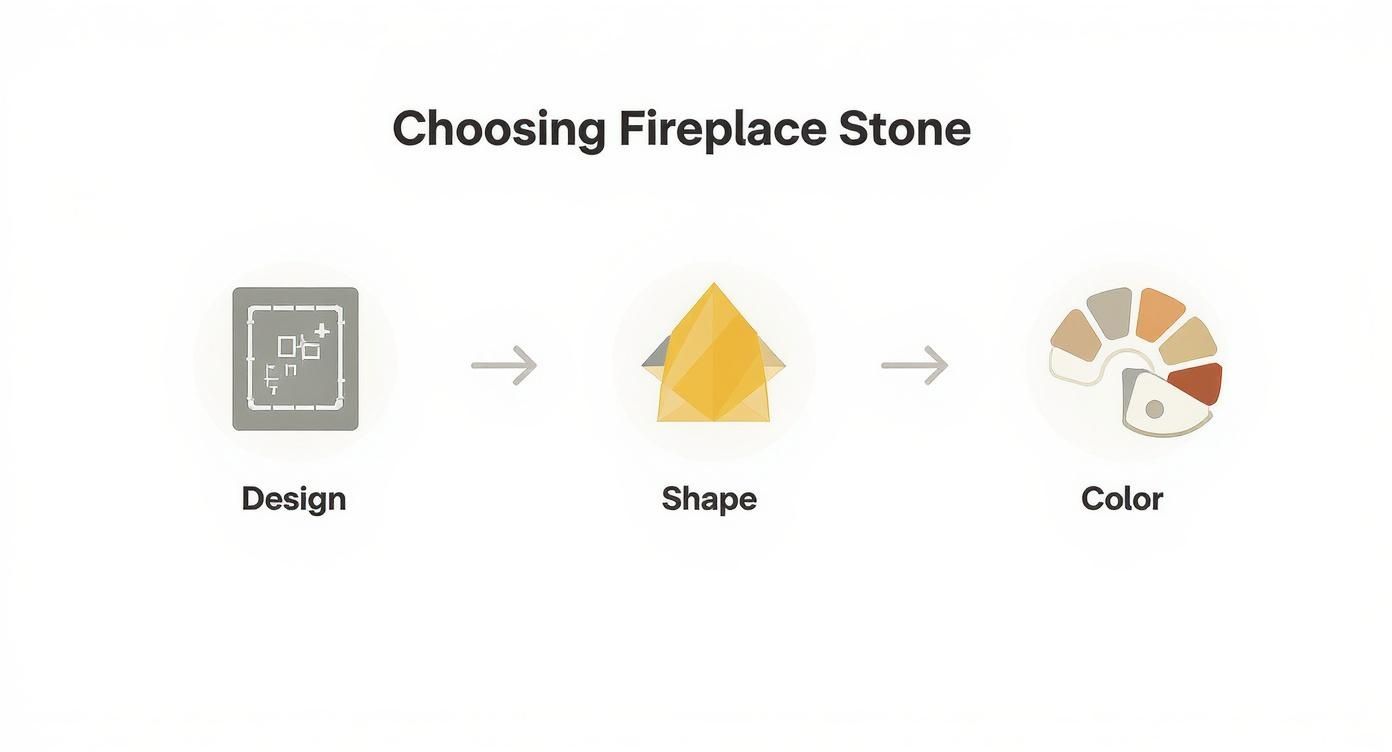
As the visual shows, a quality installation is built on a foundation of thoughtful planning.
Getting the Fireplace Surface Ready
The first phase is ensuring the fireplace substrate is clean, dry, and structurally sound. Proper preparation is essential for a strong bond and a long-lasting installation. The surface must support the veneer’s weight, which is under 15 lbs per square foot.
For new construction, this typically involves installing cement board over wood or metal framing.
- Cement Board Installation: Secure ½” cement board sheets to the studs using appropriate fasteners.
- Seam Treatment: Cover all joints and corners with fiberglass mesh tape and skim a thin layer of thin-set mortar over the tape to create a single, stable surface.
When applying veneer over an existing brick or masonry fireplace, meticulous cleaning is required. Remove any paint, efflorescence, or loose material to ensure a strong mechanical bond.
Applying Metal Lath and a Scratch Coat
With the substrate prepared, install a moisture barrier and metal lath. This framework provides a surface for the mortar to grip.
First, apply a weather-resistant barrier, followed by galvanized metal lath. Fasten the lath securely to the studs every 6 inches vertically, overlapping sheets by at least one inch.
Next, apply the scratch coat. Mix Type S mortar and apply it over the lath to a uniform thickness of approximately ½ to ¾ inch, ensuring the lath is completely embedded. While the mortar is wet, use a plasterer’s rake or notched trowel to carve horizontal grooves (“scratches”) into the surface. This texture creates a mechanical key for bonding the stone.
The scratch coat must cure for 24 to 48 hours before any stone is applied. This curing period is essential for the coat to gain sufficient strength to support the veneer.
Planning Your Stone Layout
Before mixing setting mortar, perform a dry layout. Unbox several cartons of stone and arrange the pieces on the floor near the fireplace. This allows you to create a balanced, natural-looking pattern by mixing colors, shapes, and sizes before committing.
This step also helps identify which pieces may need to be cut to fit around the firebox opening, mantel, or other features. Pre-planning minimizes cuts and waste, streamlining the installation process. For a deeper dive, view this on-demand webinar covering how to install thin stone veneer.
Setting the Stone Veneer
Once the scratch coat is cured, begin setting the stone, working from the bottom up. Start with corner pieces to establish the outside edges and create a framework.
- Mortar Prep: Mix a fresh batch of Type S mortar to a creamy, peanut-butter-like consistency that holds its shape on a trowel.
- Back-Buttering the Stone: Lightly mist the back of each stone with water to prevent it from drawing moisture from the mortar too quickly. Apply a ½ to ¾ inch layer of mortar to the entire back of the stone for full coverage.
- Setting the Piece: Press the mortared stone firmly against the scratch coat with a slight twisting motion to ensure solid contact and remove trapped air pockets. A small amount of mortar should ooze out around the edges, indicating a good bond.
- Maintaining Joints: Use temporary shims to maintain consistent spacing between stones. Adhering to essential construction quality assurance steps ensures a robust installation.
Continue this process, setting flats and corners while maintaining a varied, non-repetitive pattern. Use a wet saw with a diamond blade for any necessary cuts. After cutting, gently chip the fresh edge with a hammer to help it blend naturally.
Finishing the Mortar Joints
After the stone has been set and the mortar has cured for at least 24 hours, fill the joints. This process, known as pointing or grouting, completes the look and seals the installation.
Use a grout bag to pipe mortar deep into the joints, slightly overfilling them. Allow the mortar to set until it is “thumbprint hard”—firm but still pliable—which typically takes 30 to 60 minutes.
Once the mortar reaches the proper consistency, use a pointing tool to strike the joints, compacting the mortar and creating a clean profile. Any excess mortar on the stone faces can be removed with a stiff bristle brush after it has dried completely.
Long-Term Performance of a Natural Stone Fireplace
Choosing a material for a fireplace surround is a decision for the long term. The true value of Stoneyard’s natural thin stone veneer is realized over its long life. This is not a temporary design element but a permanent architectural feature built for generations with minimal upkeep.
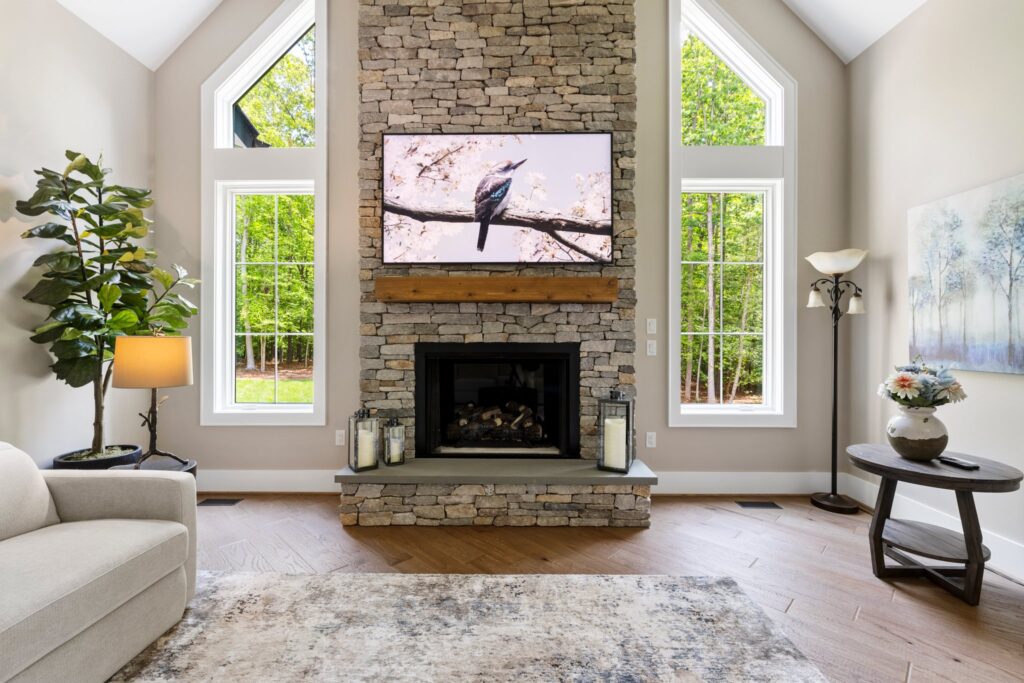
Unlike manufactured concrete products with only a thin surface layer of pigment, our real New England stone has color and character throughout its body. This fundamental difference means the stone will never fade, flake, or delaminate. It develops a subtle, natural patina over the years, enhancing its authentic character.
Built for New England Weather
Every piece of stone from our Littleton, MA facility is Harsh Climate Approved (HCA), a guarantee of proven freeze-thaw durability. Our stone is geologically dense with extremely low water absorption, enabling it to resist damage from moisture and temperature swings that cause manufactured products to fail.
Natural New England stone veneer delivers multi-decade performance with minimal maintenance and no color fading.
This inherent resilience ensures that a stone veneer on fireplace project using Stoneyard material will maintain its structural integrity and beauty for generations, whether on an indoor fireplace or an exterior chimney exposed to harsh weather.
Simple Maintenance for Lasting Character
The durability of real stone translates to low maintenance. A fireplace surround made from Stoneyard veneer does not require special treatments or coatings. For routine cleaning, brushing to remove dust or soot is typically sufficient.
For more stubborn spots, a mixture of mild soap and water with a soft-bristle brush can be used. Proper care is key, and you can find helpful expert tips for natural stone floor cleaning that also apply to vertical surfaces.
While not required for performance, some clients choose to apply a sealer for aesthetic reasons or in high-soot environments. You can learn more about the pros and cons of using a sealer for stone veneer in our guide. This is a personal preference, not a necessity for the stone’s longevity.
The long-term value of a Stoneyard fireplace lies in its permanence. It is a high-performance material that provides timeless character without the need for replacement or frequent repairs, adding real equity and authentic craftsmanship to any property.
Common Questions About Fireplace Stone Veneer
We receive many questions from builders, architects, and homeowners about using thin stone veneer on a fireplace. Here are answers to the most common inquiries.
Can I Install Thin Stone Veneer Over an Existing Brick Fireplace?
Yes. As long as the brick is structurally sound, clean, and free of paint, soot, or efflorescence, thin veneer can be installed directly over it.
To ensure a permanent bond, apply a masonry bonding agent to the brick, followed by a scratch coat of Type S mortar. This creates a fresh, rough surface for the new veneer to adhere to. For complete technical specifications, consult our full installation guide.
How Much Does Thin Stone Veneer Weigh?
Our natural thin stone veneer weighs less than 15 lbs per square foot. This is significantly lighter than traditional full-bed stone, which can be three times as heavy.
This lightweight nature is a key advantage in renovations. It typically eliminates the need for a concrete support ledge or steel lintel, allowing a stone fireplace to be added to a standard wood-framed wall without requiring costly structural engineering.
How Heat Resistant Is Natural Stone Veneer?
All thin stone veneer from Stoneyard is 100% real New England stone. It is naturally non-combustible and can withstand high temperatures, making it an ideal choice for fireplace surrounds and chimneys.
However, always adhere to local building codes and the fireplace manufacturer’s specifications for required clearances between the firebox opening and surrounding materials to ensure safety and proper function.
Does the Stone Veneer on My Fireplace Need to Be Sealed?
Sealing is not required for performance. Our stone is geologically dense and Harsh Climate Approved (HCA), making it highly durable on its own. A sealer will also alter the natural color and finish of the stone, which many people prefer to avoid.
If the fireplace is in a high-soot environment or you prefer a “wet look” aesthetic, a high-quality, breathable stone sealer can be applied. The choice is based on personal preference.
Choosing authentic stone veneer on fireplace applications is an investment in a material proven to stand the test of time. The best way to understand the difference is to see it firsthand. Request free natural stone samples to compare the quality and texture against manufactured products.
Explore the full Stoneyard Thin Stone Veneer Collection — real New England stone, made in the USA.
Order free samples at https://stoneyard.com/stone-samples/ or schedule a virtual showroom visit at https://stoneyard.com/contact/.

